The “Century Series” aircraft were a new breed of cat in their time, following the first generation jet fighters that proved their worth but had become outdated. Lessons learned from Korea revealed that aircraft such as Soviet Union MiG fighters could perform better than US jets in certain situations. Engineers went back to the drawing board and, starting with a designation of 100, launched the Century Series of supersonic fighters.
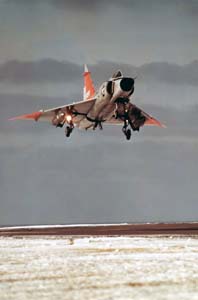 | ||
|
An F-102 takes off from Keflavik, Iceland. The Delta Dagger was far from perfect, but it was a serviceable, easily handled, and forgiving interceptor. |
The Century Series looked and flew differently, with new body and wing shapes, electronic flight controls, and afterburners to push them through the speed of sound. They were also tough to maintain. None came out of the box quite as desired, and maintenance technicians and pilots found they had much to learn to make their new charges war-worthy.
The Century Series each had different personalities, and I got to fly all of them—in situations ranging from air shows to combat—and had the opportunity to evaluate their good and bad points.
The North American F-100A Super Sabre was plagued by recurring fatal problems of loss of control at high speeds and high G forces, and demanding max performance from an A model often resulted in violent compressor stalls that would blow flames out of both ends of the aircraft. It was not a universally admired bird, but during my tenure with the Thunderbirds, the team received six vastly improved, factory-fresh C models. These proved to be dependable for our demanding show routine. The fighter’s smooth flight controls and increased power fit our show perfectly, and we could turn around tightly enough between maneuvers to keep the show in front of the crowd. But the big fun new thing was the afterburner. From behind a crowd, the roar and fire of four unannounced burners lighting overhead was a real attention getter.
Nuclear-capable C models equipped two European wings, and transoceanic flights, eventually with air-to-air refueling, became common. The factory converted to more sophisticated and heavier D models, later stretching the D into a two-seater called the F-100F.
Then came Vietnam, with heat, humidity, and long supply lines. Support personnel had amazing success in keeping their aircraft combat-ready for aircrew, who flew multiple missions while dodging enemy ground fire. The F-100s were good at their prime mission of close air support of ground forces, but also found themselves escorting other aircraft within the combat zones, seeding the North’s supply routes with various munitions, and flying armed reconnaissance missions.
Suddenly the Super Sabres were needed up north, in ugly places around Hanoi, with the fiercest air defenses in the history of aerial warfare. The first anti-surface-to-air missile units, “Wild Weasels,” comprised flights of F-105 “Thuds” augmented with F-100Fs that had their rear cockpits filled with first generation SAM-seeking electronics. The Weasels preceded the strike aircraft into the target area, attempting to clear the route of SAMs by searching electronically for and attacking the SAM sites and their radar control units while exposing themselves to attack. That was a terribly tough job with staggering loss rates, so for morale purposes the F-100 pilots adopted the slogan, “First In, Last Out.”
It really meant the 100s were much slower than the Thuds, so they had to enter early, and were left behind on the way out.
The first Century Series interceptor was the Convair F-102 Delta Dagger. Despite drastic redesign of early prototypes, the “Deuce” didn’t have the desired zip and couldn’t go supersonic if external fuel tanks were installed. The air intakes were not adequate at high angles of attack, and in a snap-up intercept—calling for max power, high speed at high altitude, and a hard pull up—Deuce pilots had to throttle back to minimum burner or risk an immediate engine overheat and damage. Not good, but most systems were reasonably reliable, and the Delta Dagger was a serviceable interceptor. It handled easily and honestly and was forgiving. Initial armament included radar and heat-seeking missiles plus “Mighty Mouse” folding-fin rockets, with nuclear missiles coming later.
Pointing at the Half Dollar
In 1956 the 102 became operational with Air Defense Command and immediately got cold weather duty along the Pinetree Line, stretching from Vancouver, British Columbia, Canada, to the Great Lakes and on up Canada’s eastern shoreline. By 1958 things got even colder as Deuces inherited the far-north warning line from Anchorage, Alaska, to Thule, Greenland. The mission was to keep Russian bombers from heading for the heart of America.
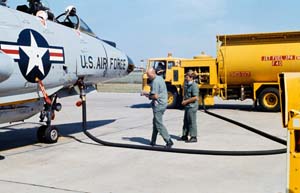
| ||
| USAF fuel specialists refuel an F-101 Voodoo on the flight line at the Air National Guard Base at Hector Arpt., N.D. (USAF photo) |
The Deuces always kept busy at Goose Bay, Labrador, in Canada, where winter winds and temperatures of negative 40 degrees drove chill factors off the charts. Four inches of ice commonly covered the runways and taxiways, with 30-foot-high rock solid snowbanks along both sides.
US and Russian commercial aircraft would make regular penetrations of the defense zones, but if they were off schedule, Deuces from Goose Bay would be scrambled. Russian military aircraft often headed straight for Goose until radio chatter indicated a scramble in progress.
Deuces saw temporary duty in South Vietnam and Thailand. They pulled alert duty, escorted nightly B-52 strikes, and looked for MiGs. But the MiGs didn’t have the legs to come south, nor did the Deuces go north. In their only meeting, over Laos, a MiG-21 shot down a Deuce.
The real glamorous celebrity of the Century Series was the Lockheed F-104 Starfighter—the missile with the man in it—known as the “Zipper.”
Mach 2 was an easy task, and the F-104A-model interceptor checked in at 1,404 mph and 91,249 feet altitude and was an absolute ball to fly. A pilot felt as if he were part of some awesome hardware, and it was even fun to taxi. At takeoff throttle you were in charge of the world’s fastest tricycle. Normal climb was at a 45-degree angle, and you could sit with minimum stick movement and zip through Mach 1—or wait a bit and check Mach 2.
A bird of this nature could be tough to handle if it balked. During a flight in 1959 I was in the clouds, going through 24,000 feet in a max vertical climb, when the lights and flight instruments went out with electrical failure. Almost invisible on the top left of the instrument panel were a half-dollar-sized emergency attitude indicator and a magnetic compass, not a lot of help at that moment. Recovery from something like that is almost too much. I had to get the nose down and do some seat-of-the-pants flying, while cross-checking that tiny attitude indicator. I came out of burner, fed in left rudder and aileron, and gave her some forward stick pressure to get into a smooth, descending arc.
As I came closer to something that looked and felt almost like level attitude, I broke into a small clear tunnel in the clouds on my left with a round blue spot at the end. I didn’t know if it was water or sky, or if it was up or down, but I had plenty of altitude, so I went for it. It turned out to be sky, and that led to a good repositioning for recovery.
In the “Four” you also always had to keep a close eye on your fuel supply, since there wasn’t all that much of it, and it went in a hurry if you were maneuvering at max performance.
Not too many USAF pilots got to fly the Zipper, as the gears went for minimum production of 104s and a push for nuclear-capable F-105s. The thinking was that there would be no more conventional air warfare, and everything in the future would be nuclear. That thinking later cost us in Vietnam.
Despite tepid US interest, the Four was a hot item within NATO. The safety records were grim, but overseas production and sales were welcome, and the air shows were great.
The US sent Zippers to Vietnam, and that was a mismatch. The guys tried, hanging a single bomb under a wing, but the Four was simply not well-suited to hunt for trucks in the jungle or for dueling around downtown Hanoi.
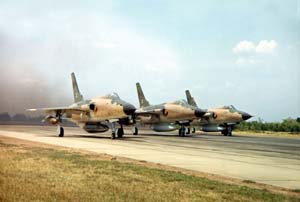
| ||
|
F-105s take off for a Rolling Thunder mission over North Vietnam. (USAF photo) |
The F-101 Voodoo saw its own teething pains. Preproduction engineering voices at McDonnell Aircraft warned they needed two more years to overcome a severe aerodynamic problem that caused the F-101 to pitch up and depart control. The engineers were ignored, and the Voodoo never recovered from that decision. Initial production runs of A and C models wound up flying out of England, tasked as nuclear bombers, but they were pitch-up prone and difficult to maintain.
Pitching Up
New pilots were routinely briefed that the aircraft was dangerous, could climb like mad, took half of the stratosphere to do any vertical maneuvers, and had never forgiven anyone, ever.
In simplest terms, pitch-up could happen when the nose was pulled to an angle that interrupted the airflow over the tail section, and caused the aircraft to go bananas.
“At 38 thou, tangling with two Voodoos. … Yo-yo [steep climbing turn trying to get above and behind them]. … Nose snapped up, stick useless,” read one excerpt from a pilot’s account. “Violent snap left to inverted spin. … Nose back up to vertical. … Engines stalling. … Tail slide to inverted. … Spinning left. … Nose snapped vertical, tail slide, left spin back to vertical, then tail slide and back up to vertical for another tail slide. … Standard recovery futile. … Deployed drag chute, nose down, hanging absolutely vertical, airspeed increased to 130, got stick feel, leveled at 20 thou.” Fortunately, this pilot had 18,000 feet to spare.
The factory attacked the problem with a stick pusher, a system whose delicate computerized sensors constantly measured the nose’s angle, and if the angle, the airspeed, fuel load, and G forces didn’t match the desired chart figures, the computer kicked the pilot’s control stick forward. This did not solve the pitch-up problem, and since the push could come in the wrong place at the wrong time, the pusher was involved in fatal and near-fatal accidents.
Then there were bothersome things such as a large, unprotected, hidden electrical junction called “the pineapple.” It was prone to catch stray washers or bits of wire that could lodge between any number of contact points to provide the crew with surprises, like jettisoning the canopy at night in a thunderstorm.
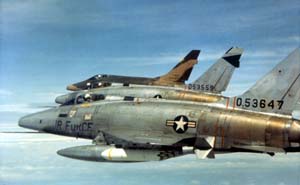
| ||
|
F-100 Super Sabres sometimes arrived in country unpainted, but were eventually given the camouflage scheme sported by the aircraft at top. (USAF photo) |
But the Voodoo was very fast, had good instruments and navigation capability, flew straight lines OK, and could go over the top of a snap-up at 58,000. It also carried the nuclear AIR-2 Genie rocket—supposedly effective against bomber formations if detonated in their general area. McDonnell delivered B models for 18 Air Defense Command squadrons, and they quickly became part of US defense lines. They never saw any combat, however.
The combat heroes were the supersonic RF-101C photoreconnaissance Voodoos, which did good work over Vietnam. Management wanted detailed photo coverage after every strike against the North, and the SR-71s and the U-2s got the high assignment, while the unarmed RF Voodoos got the low assignment.
When F-105s finished bombing a target, the locals were understandably upset. That’s when a photo Voodoo pilot was required to fly over the same target—and defenses—while taking pictures of the damage. The pilots used their birds’ speed to streak in, cameras churning, get their bomb damage photos, and get out of there as best they could—and they did a superb job.
Convair was still studying lessons learned from the Deuce as requirements firmed up for the “Ultimate Interceptor.” It entered the force as the F-106 Delta Dart. Pilots had always wanted the Deuce to do a little more, a little better, and they got their wish when the “Six” started moving into perimeter defense positions around the US. The Six set a world speed record, but more important to operators, it made difficult, high-speed and high-altitude intercepts easier to accomplish. The nuclear Genie rocket was an added deterrent. The Six was as big as a C-47 but handled like a little scat-cat.
Delta Scramble
The cockpit was designed for pilots: The primary flight instruments were eye level vertical tapes, far easier to interpret than round gauges and pointers. A pilot could set moveable horizontal indexes for altitude, airspeed, etc., and matching horizontal bars moved up and down the tapes in response to the aircraft’s motions. If a quick visual scan showed all the little bars in a straight line across the panel, you were doing it right. The animated, television-like tactical situational display illustrated the positions of friends and foes, provided a real-time presentation of intercept progress, and showed how to get to the next checkpoint or destination.
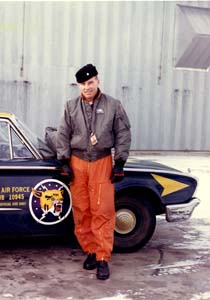
| ||
|
Author and Century Series pilot Jack Broughton at Minot AFB, N.D. (Photo courtesy of Jack Broughton) |
Buttons and switches that could activate all mission essential and weapons functions covered the dual-handled control stick. The radar was efficient, and once locked onto a target it provided a clear, steerable presentation to get to missile firing position. If you locked on from an angle or elevation where steering to the firing point would be difficult or manually impossible, you could click the autopilot takeover button and hang on for the wild aircraft gyrations that would take you to the firing point.
All squadron pilots got to fly the Dart’s max performance mission one time. After a burner takeoff and climb, the pilot leveled at 35,000 feet, then let it roll for a few hundred miles to Mach 2 and a bit more—where things get really quiet. Smoothly reducing power, easing into a reverse climbing turn, and leveling about 60,000 feet would allow the pilot to retain idle throttle while coasting back to base to land. All this took about 17 minutes.
Due to their position in the US defense plan, Dart squadrons took frequent no-notice alerts and scrambles seriously. An exercise, code-named Flush, simulated a high probability of missile attack in advance of bomber penetration. One black, cold winter morning, Flush started with an alert call at 12:25 a.m. Five hundred enlisted personnel and 50 officers started running through blowing snow at 28 degrees below zero, and at 1:40 a.m. all 26 of the squadron’s 106s were ready on the flight line.
Five minutes later pilots were strapped in, radios on, ready to push the start button. Every crewman and pilot that day could say the next 22 minutes were the coldest in their lives. At 2:07 a.m. radios barked, “Flush,” and 25 jets roared to life while one cold-soaked bird burst its hydraulic lines and bled in the snow. Six minutes later they were airborne, afterburners roaring.
The alarming problem with the Six was that the ejection seat would not work. Thirteen attempts at ejection were fatal. After pulling the ejection handles, more than 30 separate, sequential, manual operations had to be completed successfully before the first squib in an electronic-explosive ejection sequence could operate. The backup manual system was physically impossible to operate when strapped into the seat. Almost constant inspection and alignment by highly skilled and dedicated technicians made no difference. The seat was a killer.
It took a career-threatening campaign against industry and higher headquarters, but we finally replaced the killer seats for the entire 106 fleet. When the last 106 retired two decades later, the new seat had a 100 percent success rate within parameters.
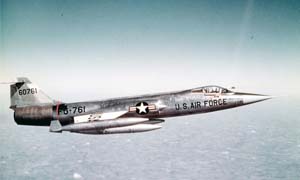
| ||
|
The F-104, below with tip tanks and pylon tanks, was the glamour girl of the Century Series. Pilots learned to keep an eye on the instruments when flying the Zipper. (USAF photo) |
The Six never got to go to war, but she sure would have fit in well on F-105 missions. Operational combat commanders asked our headquarters requirements chief to push for speeding up existing programs that were modifying the Six with air refueling, a gun, a bubble canopy, and an infrared sight, and to get us the fighters ASAP. We would have loaded the huge weapons bay and delta underwing with cluster bombs and Sidewinder missiles and used them as the lead flight on Hanoi area strike missions. They could have suppressed lots of flak and zoomed up off target to keep the MiGs off the strike aircraft. But the suggestion was not well-received.
Of all the Century Series birds, the Republic F-105 Thunderchief probably had the toughest time getting into full production, due to vacillating mission requirements and extensive, recurring contract skirmishes. By the time the B models got to tactical units it was clear that while the Thud retained conventional air warfare capabilities, those calling the shots were far more interested in high-speed, on the deck, nuclear delivery capability.
The early Thuds were a maintenance nightmare with unacceptable readiness rates, but as improved D models appeared, they were used to upgrade the US worldwide nuclear posture. Not too many people really liked the Thud by then.
Dreaming of an F-106
There was hope of a better image when the Thunderbirds ran a few of the old B models through an extensive depot level rework and applied air show colors. As show season opened, the team flew a few arrival maneuvers for a San Francisco show. As they pulled to vertical, Thunderbird Two had a wing fold and separate, and then crashed.
The Thud’s stock hit an all-time low.
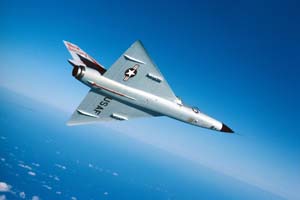
| ||
|
The F-106 suffered from faulty ejection seats, and 13 pilots died when trying to punch out. The Dart went on to become the ultimate interceptor of its time. (USAF photo) |
Vietnam changed that. Suddenly conventional air warfare was no longer passé. Individual Thud squadrons began rotating to bases in Thailand on conventional warfare temporary duty, while others at home base maintained their nuclear commitments. As soon as facilities were available two Thud wings became Thailand tenants, dedicated to striking the North. The Thud was at war. Among the first of many aircraft modifications, the Thud’s internal nuclear weapons bay became a large fuel tank. All aspects of conventional air superiority, such as gun sights, became important again.
Thuds hauled 75 percent of all the bombs that went north on attacks against the Hanoi area, and we lost about half of the entire F-105 fleet, plus pilots, in the process. Wild Weasel missions became more successful as extensively modified two-seat Thuds entered the fray. Thuds performed all their combat tasks well, and the ugly duckling of the Century Series became the most successful and admired warhorse of the bunch.
Having flown 56 different aircraft, I often get asked to pick a favorite. My reply is a fantasy that, on a night with a few puffy cumulus clouds and a bright full moon, my wife and I roll our highly modified 106B two-seater out of the garage.
Jack Broughton is a retired USAF colonel and fighter pilot. During his time on active duty he was the recipient of four Distinguished Flying Crosses, two Silver Stars, and the Air Force Cross. He is the author of two memoirs from the Vietnam War era, Thud Ridge and Going Downtown. This is his first article for Air Force Magazine.